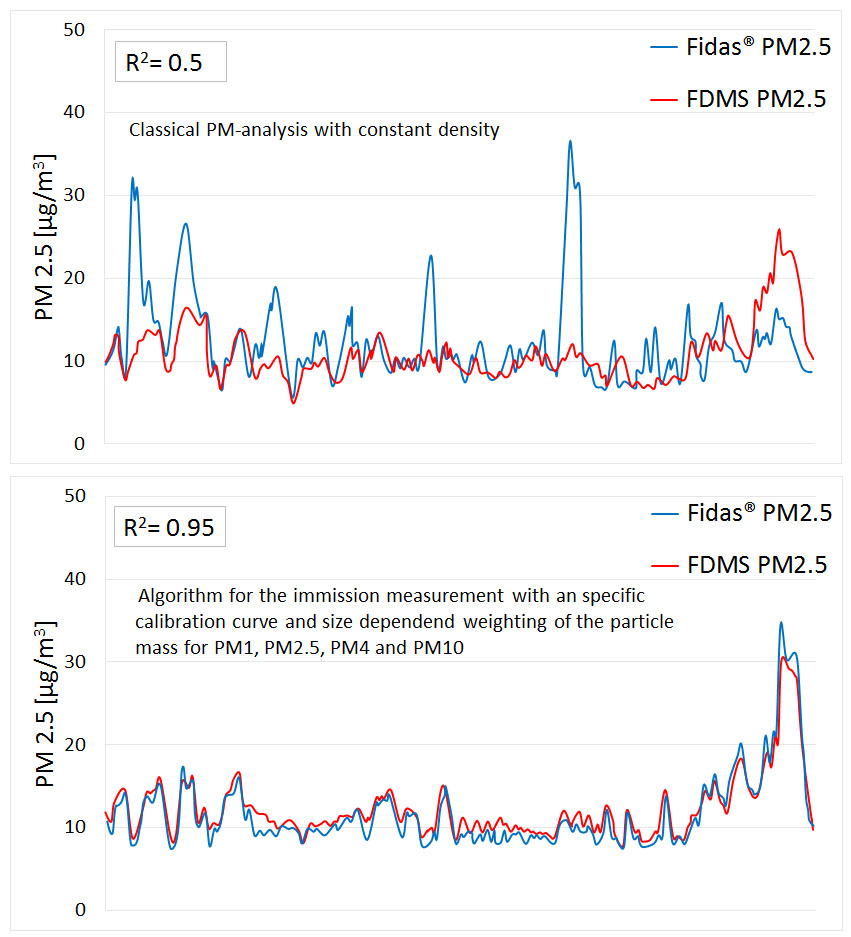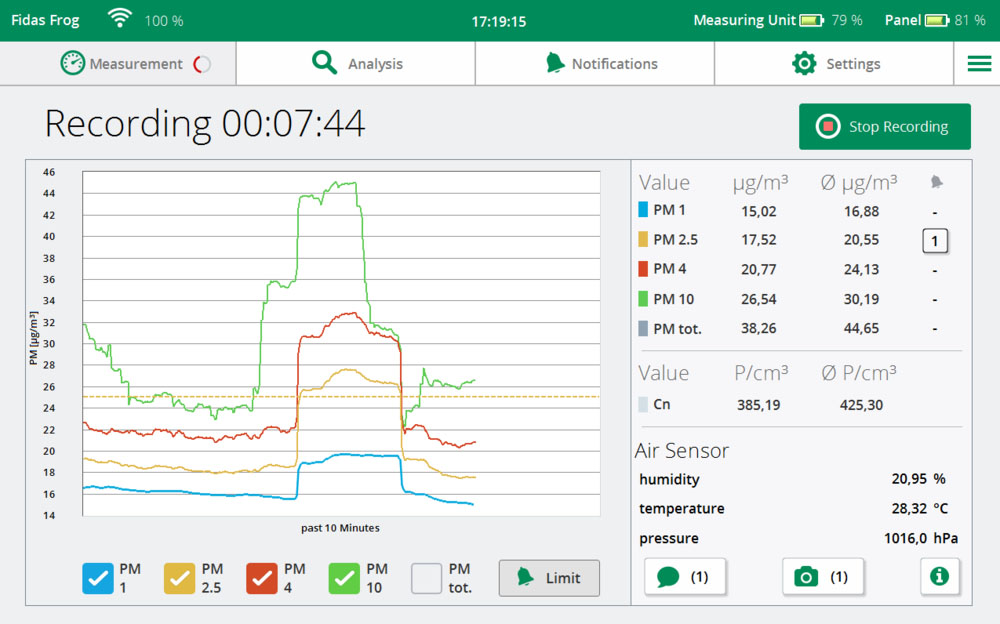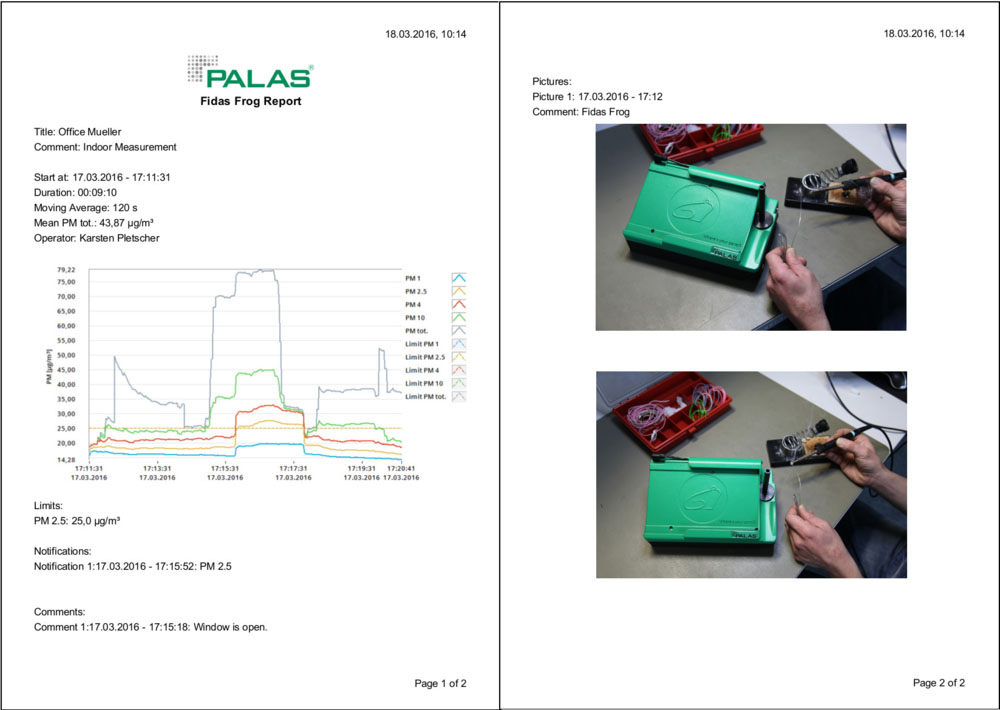Fidas® Frog DE STERS 04.12.2023
Fidas® Frog
Battery powered, portable fine dust measurement device with detachable control panel, for outdoor, indoor and workplace measurements based on EN 481
The fine dust measurement device Fidas® Frog allows for a fast, reliable, and quality-assured determination of fine dust, e.g., monitoring within the scope of Health, Safety, and Environment (HSE) management at workplaces (exposure assessment) or in the range of indoor air quality measurements (e.g., for offices, public buildings such as schools, passenger compartments…).
It simultaneously measures the environmentally relevant mass fractions PM1, PM2.5, PM4, PM10, and TSP, as well as the particle number and the particle size distribution within the particle size range of 0.18 – 93 µm. By providing fine dust values with high time resolution, the operator receives comprehensive information for evaluation and assessment of the fine dust pollution for the investigated application.
The very compact and light design as a portable hand-held monitor with either battery or mains power operation and the operation time of up to 8 hours per battery charge allow for a flexible application of the Fidas® Frog at any measurement sites.
Norms and certificates
National and international standards
Operation principle
Portable fine dust measurement device
Fidas® Frog communicates via WLAN with its wireless operator´s panel (Tablet). By this, it is possible to perform measurements with a distance between the measurement site itself and the operator of the Fidas® Frog, e.g., for sites challenging to access. This concept furthermore allows for integrating one or more Fidas® Frog in an existing network and controlling® Frog in an existing network and controlling the connected devices from one central PC, e.g., for area-wide monitoring of a production facility.
Fidas® Frog uses the recognized measurement technology of optical light scattering of single particles and is equipped with a LED light source with high intensity (dp min = 180 nm), highly stable output, and a long lifetime. The sensor and the evaluation routines of the Fidas® Frog are also used in the Fidas® 200, which is certified for monitoring of PM2.5 and PM10 in ambient air by TÜV/Umweltbundesamt and which have been validated in comprehensive comparison campaigns versus the gravimetric reference method.

Fig. 1: Higher sensitivity with the Fidas® fine dust measurement system for the 0.18 – 18 µm particle size range
By implementing this well-approved technique and by the numerous measures for quality assurances during production (e.g., comparison of each Fidas® Frog with a certified Fidas® 200), precise and quality-assured measurements can be ensured.
The system’s calibration can be checked and adjusted, if necessary, easily and quickly under field conditions on-site at any time with the help of a monodisperse test powder.
Fidas® Frog operates with a volume flow of 1.4 l/min and is equipped with sensors for environmental conditions, temperature, atmospheric pressure, and relative humidity.
The actual aerosol sensor is an optical aerosol spectrometer that determines the particle size using Lorenz‐Mie scattered light analysis of single particles. The single particles move through an optically differentiated measurement volume that is homogeneously illuminated with white light. Each particle generates a scattered light impulse detected at an angle of 85° to 95° degrees. The particle number is measured based on the number of scattered light impulses. The level of the scattered light impulse is a measure of the particle size diameter.
The lower detection limit for immission measurement could be reduced to 180 nm through improved optics, higher light density using a new white LED as the light source, and improved signal analysis (logarithmic analog, digital converter). This enables greatly improved detection, especially of smaller particles mainly found at high concentrations near roadsides (see Fig. 1).
The better the classification accuracy and the resolution capacity, the more accurate the definition of the particle size distribution.
A white light source enables a precise and unambiguous calibration curve, resulting in an extremely high size resolution. The patented T-stop provides a precisely defined optical measurement volume and enables particle measurement without border-zone errors, resulting in a precise size measurement. The new digitized electronic signal analysis system enables the rapid identification and correction of coincidence, as necessary.

Fig. 2: Comparison of the algorithms for conversion of the particle size distribution by PM value
To convert the measured values into a mass or mass fraction, the high-resolution particle size distribution in each value is multiplied by a correlation factor that reflects the different sources (e.g., combustion aerosols, tire wear, pollen) of the environmental aerosol (see Fig. 2). A mass fraction is obtained by additionally applying the separation curve to the determined particle size distribution. Multiple separation curves can be used simultaneously for the same size distribution, which enables the simultaneous output of PM10, PM2.5, PM1 (and others). For example, the Fidas® Frog can be operated with the same conversion algorithm, which has also been implemented in the type-approved and certified ambient air monitoring system Fidas® 200 for regulatory monitoring of ambient PM2.5 and PM10 concentrations.
The operation of the Fidas® Frog is intuitive and simple. All measured data can be evaluated and compared directly with the operator interface. Already during the measurement, messages on exceeded limit values are possible. These limit values can be defined based on legal requirements or individual needs (see limit values in Fig. 3).

Fig. 3: Display of measured values during a measurement
An integrated camera documents the measurement setup. By this, pictures can be added for documentation directly and comfortably to the measured data set or the measurement report in pdf generated by the device itself. Fig. 4 shows such a measurement report in pdf, including data of the measurement conditions saved by the user and a graphical evaluation of the measurement data. Pictures of a workplace measurement have also been attached to this report.

Fig. 4: Example for a measurement report (pages 1 and 2)
The measured data can be directly printed or transferred to an USB stick via the micro-USB-port and processed on an external PC. In this case, the evaluation software PDAnalyze Fidas® offers various data evaluations, especially for the particle size distribution, and it gives possibilities for export.
Benefits
Your special advantages
- Continuous and simultaneous real-time measurement of PM1, PM2.5, PM10 and TSP-values
- Additional particle number concentration and particle size distribution
- Wide measuring range: 0.18 – 93 µm
- Adjustable time resolution from 1 s
- Direct comparison of different measurements
- Configuration of limit values possible
- High quality of measuring data through implementation of the sensor / evaluation algorithm of EN-certified Fidas® 200
- Additonal expanded range of applications by possible separation of the measuring device and the Tablet-PC for control (communication via WLAN)
- Up to eight hours of measurement time in battery mode
- Ergonomic design and low weight
- Intuitive and simple operation
- Integrated camera for documentation of the measurement
- Export function for measured data
- Possibility to generate a measurement report as pdf in Fidas® Frog
- Remote monitoring and control via network integration easily possible
- PDAnalyze Fidas® software for individual analysis of your measurement data on an external PC
- Check of calibration with test powder on site possible
- Reliable function
- Few maintenance
- No radioactive material
- No consumables
- Sensors for barometric pressure, temperature and rel. air humidity
Applications
Individual solutions for various industries
- Fine dust monitoring at alternating locations or in movement
- Air quality monitoring indoors, at the workplace, or inside vehicles
- Use as an aerosol spectrometer in setups where space is limited
Technical features
In detail
| Measurement range (number C_N) | 0 – 20,000 particles/cm³ |
| Size channels | 32/decade, 256 raw data channels |
| Measurement range (size) | 0.18 – 93 µm (2 measurement ranges) |
| Measuring principle | Optical light scattering at single particles |
| Reported data | PM1, PM2.5, PM4, PM10, TSP, CN, particle size distribution |
| Measurement range (mass) | 0 – 100 mg/m3 (depending on the composition of the aerosol) |
| Volume flow | 1.4 l/min |
| Data acquisition | Digital, 20 MHz processor, 256 raw data channels |
| Light source | LED |
| Power consumption | 13 W |
| User interface | Touchscreen, 1,280 • 800 pixel, 8″ (20.32 cm) |
| Housing | Synthetic housing |
| Weight | Ca. 2,1 kg (Bedienpanel: 0,4 kg, Messeinheit: 1,7 kg) |
| Operating system | Windows 10 |
| Data logger storage | Approx. 16 GB (extendable by micro-SD) |
| Battery operation | Li-ion batteries, non-removable, base unit: 77 Wh (14.8 V; 5,200 mAh), 8 cells tablet: 20 Wh (3.8 V; 5,200 mAh), 2 cells |
| Installation conditions | 0 – +40 °C |
| Interfaces | USB, Ethernet (LAN) by USB-adapter, Wi-Fi access point |
| Dimensions | 100 • 240 • 150 mm (H • W • D) |

